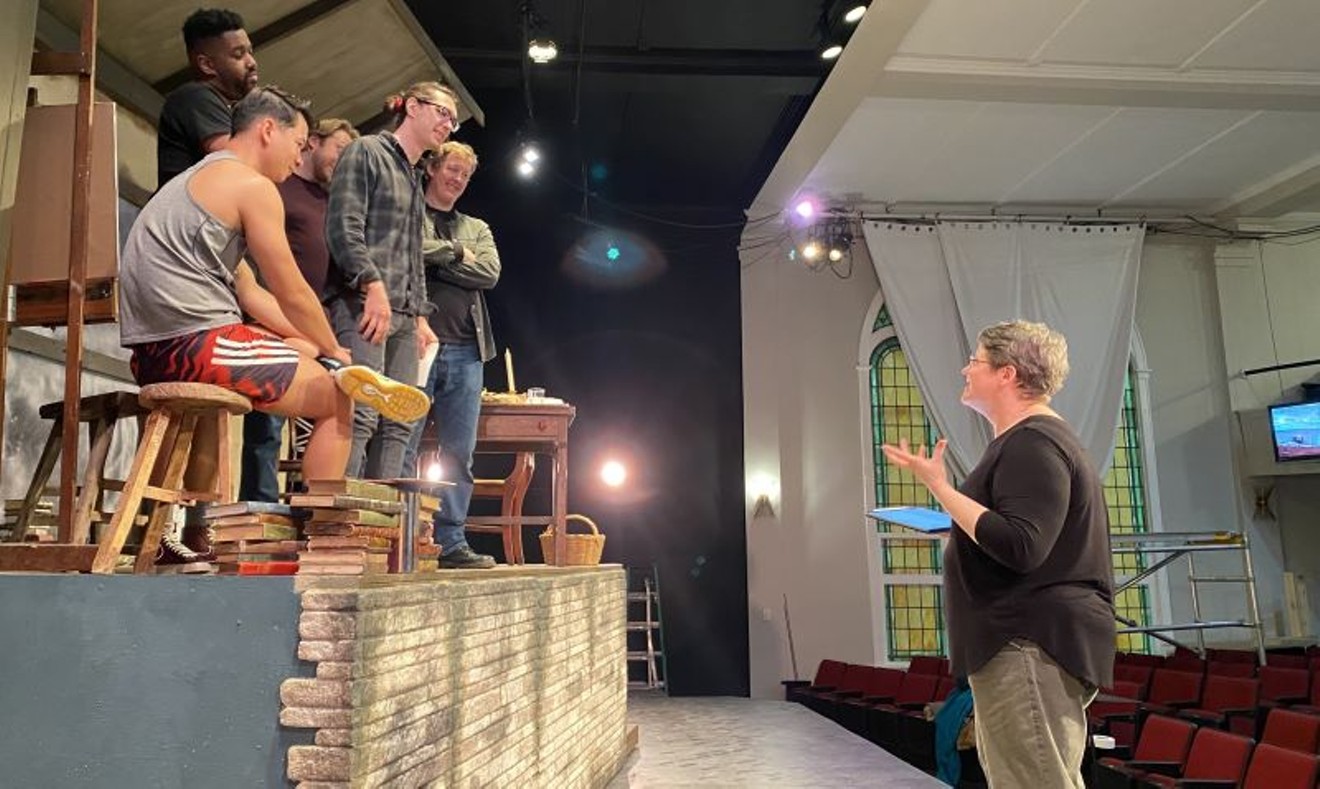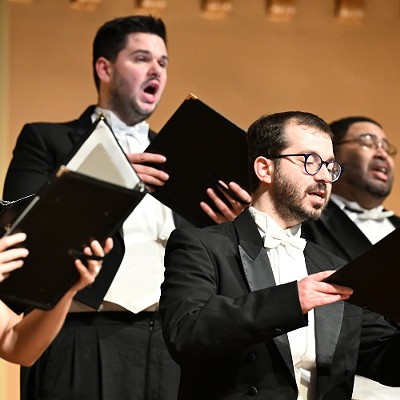Support Us
Houston's independent source of
local news and culture
account
- Welcome,
Insider - Login
- My Account
- My Newsletters
- Contribute
- Contact Us
- Sign out
La Boheme at Opera in the Heights Stays in Paris But Moves to the 1920s
Margaret Downing April 3, 2024 4:00AM

Stage Director Nicole Kinley-Miller in rehersal with the cast of La Boheme.
Photo by Eiki Isomura
[
{
"name": "Related Stories / Support Us Combo",
"component": "11591218",
"insertPoint": "4",
"requiredCountToDisplay": "4"
},{
"name": "Air - Billboard - Inline Content",
"component": "11591214",
"insertPoint": "2/3",
"requiredCountToDisplay": "7"
},{
"name": "R1 - Beta - Mobile Only",
"component": "12287027",
"insertPoint": "8",
"requiredCountToDisplay": "8"
},{
"name": "Air - MediumRectangle - Inline Content - Mobile Display Size 2",
"component": "11591215",
"insertPoint": "12",
"requiredCountToDisplay": "12"
},{
"name": "Air - MediumRectangle - Inline Content - Mobile Display Size 2",
"component": "11591215",
"insertPoint": "4th",
"startingPoint": "16",
"requiredCountToDisplay": "12"
}
]
With a cast full of singers making their role debuts, a children's chorus accompanying the adults and a plan to bring the action out into the aisles of Lambert Hall, Opera in the Heights is staging a production of La Boheme unlike anything you've seen before.
That's the promise made by Artistic and General Director Eiki Isomura who will conduct and Stage Director Nicole Kenley-Miller who is back in Houston for Puccini's's work set in Paris in the 1830s showing the street life of artists of the time.
The two main characters are Rodolfo, a poet, and Mimi, a seamstress, who fall in love in a moment's meeting. They and their friends, all struggling artists, scrape by financially as they pursue what was known as a Bohemian lifestyle.
Opera and life being what they are, the course of this true love does not run smooth. Mimi gets sicker and sicker. Rodolfo decides the that best thing he can do for Mimi is to break things off so she can take up with a wealthier suitor more able to afford the medical help she needs for what is assumed to be consumption or tuberculosis. Eventually, the two of them are reunited, but it is too late for much of a future together. She sings her last compelling aria and dies.
Asked why he wanted to do the oft-performed La Boheme, Isomura says: "It is one of the most beloved pieces by all of us. By audience members, of course, and for performers, singers, orchestra members alike, it holds a special place in our hearts. For the artists that Opera in the Heights serve these are really important roles for them to add to their resumes. We're very fortunate to have found a group of singers who are absolutely perfect and haven't had a chance to sing them before. So we have a cast full of role debuts who are absolutely born to sing these roles."
That cast includes tenor Brian Vu as Rodolfo, soprano Ashley Milanese as Mimi, soprano Caitlin Aloia as Musetta, baritone Kellen Schrimper as Marcello, baritone Adam Richardson as Schaunard, bass Griffen Hogan Tracy as Colline, Zack Scott Frank as Benoit/Alcindoro and Cody Ryan Arthur as Parpignol/Chorus.
"With all Puccini there are twists and turns almost every bar in the music," Isomura says. "Puccini was such a master in pacing the music that a way that tells us everything about about what they’re experiencing. It is our privilege and and task to make it come to life in a way that feels honest."
Kenley Miller, who is now assistant professor of music and opera stage director at the University of Oklahoma, was previously the production manager and stage director for the University of Houston's Moores Opera Center. This is the third production she has directed for Opera in the Heights, after doing Amahl and the Night Visitors and Gilbert and Sullivan. So she is used to working with the stage at Lambert Hall.
"I'm not going to lie, that's been challenging, she says laughing. Isomura applauds her efforts in this regard, saying, "She’s done a terrific job in utilizing the entire theater to tell the story."
With a cast of seven principals as well as an adult chorus of 15 and a children’s chorus of 12, it's difficult to get everyone on stage, particularly in the Act II street scene. That's in part why, there will be singers coming out into the audience which Kenley-Miller describes a very immersive but not interactive experience. Audience members can rest easy on that.
"The audience will feel like they're part of the street scene,, that the vendor is selling flowers directly to them" she says. "That the vendor is selling the flowers directly to them," she says. "I think it's going to feel very alive and vibrant and the audiences is right in the middle of all of that bustle."
The opera is still set in Paris as it was in the original but has been moved forward to the 1920s at Kenley-Miller's direction. "I really am interested in that era especially in Paris and in France in the 1920s," she explains. "It was such a dynamic time in history, particularly for art. It was a time when lots of new things were happening. It was a time of artists. The art scene in Paris in the '20s was on fire.
"And of course I love the fashion at that time. Everything was changing in that period, hemlines and silhouettes for women, there was just a lot of liberation going on.
"As a woman director, I am always trying to figure out how to find a sharper focus to the women characters in the opera. For instance, Mimi. She traditionally has been played in a sort of angelic more Victorian way. But in the original source materials for Boheme, Life in the Bohemians by Henri Murger, she is a grisette and the definition of a grisette is she does stitching or sewing work by day and by night she has gentlemen callers to make a living.
"I think the '20s period allows us to lean into that a little more. She’s not going to be wildly different cause the music that Puccini wrote doesn't necessarily allow for that. but I did want to amplify that aspect of her character to make it just a little more complex
"Sometimes in Puccini's operas the detail of the male characters is filled in a little more than the detail of the female characters. So it's always my approach as a female director to make sure that we're finding all the complexities."
Asked why La Boheme has been so popular for so long, Kenley-Miller responds: "I think it’s the characters and the story. It’s probably Puccini's tightest opera in the terms of the dramatic pacing and the character development and just how specifically, realistically he created this world. For me, at the end of the day, yes the music is fantastic and you're going to feel vibrations of that singing like you've never felt before at Lambert Hall, but at the end of the day it's the story for me that I take home.
"It’s a group of friends, it's a community who support each other through good times, through bad times, through laughter, through tears even up to death They're sort of this ragamuffin band of friends and for [Rodolfo] they are his family."
The final moment of the opera are so important because that's when Mimi In her dying aria, expresses all the love she has for Rodolfo, Kenley-Miller says. "It's the last thing she wants to say to him. She is really intent that he hear her. That she loves him as big as the sea. To me that's the beauty of what operatic music offers. It let's us feel big."
Thanks to the smaller setting employed at Lambert Hall is that Isomura and his orchestra are close by the singers, making it easier to hear them and avoid overwhelming them with too much loud as happens sometimes elsewhere. "The music making feels somewhat closer to chamber music. That makes the balancing part of it more intuitive than it might be otherwise," Isomura says, adding:
"[La Boheme is] the perfect piece to discover one's love for opera. It’s also the perfect piece for people to rediscover their love for an opera that's very ubiquitous. It’s programmed every year by some companies and that is a testament to how evergreen the piece is. It has been the experience of so many of our loyal supporters who are opera devotees, who say 'It feels so fresh here.'"
Kenley-Miller shares Isomura's enthusiasm.
"This is going to be an experience of Boheme that you haven’t had before," she says. "You'll be up close to the actors and the singers and you're going to feel their voices. To not only hear Puccini and to see it but also to feel it in your body is also going to be a different experience than I think you might have if you're in a larger theater. .
Performances are scheduled for April 5, 7, 12 and 13 at 7:wp Fridays and Saturday and 2 p.m. Sunday at Lambert Hall, 1703 Heights Boulevard. Sung in Italian with English surtitles. For more information, call 713-861-5303 or visit operaintheheights.org. $29-$85.
KEEP THE HOUSTON PRESS FREE...
Since we started the Houston Press, it has been defined as the free, independent voice of Houston, and we'd like to keep it that way. With local media under siege, it's more important than ever for us to rally support behind funding our local journalism. You can help by participating in our "I Support" program, allowing us to keep offering readers access to our incisive coverage of local news, food and culture with no paywalls.
Margaret Downing is the editor-in-chief who oversees the Houston Press newsroom and its online publication. She frequently writes on a wide range of subjects.
Contact:
Margaret Downing
Follow:
Facebook:
HoustonPress
Twitter:
@HoustonPress
Trending Arts & Culture
- The Hills Are Alive at the Wortham With HGO's The Sound of Music
- The Father at 4th Wall is Its Own Long Day's Journey Into Night
- The 10 Best And Most Controversial Hustler Magazine Covers Ever (NSFW)
-
Sponsored Content From: [%sponsoredBy%]
[%title%]

Don't Miss Out
SIGN UP for the latest
arts & culture
news, free stuff and more!
Become a member to support the independent voice of Houston
and help keep the future of the Houston Press FREE
Use of this website constitutes acceptance of our
terms of use,
our cookies policy, and our
privacy policy
The Houston Press may earn a portion of sales from products & services purchased through links on our site from our
affiliate partners.
©2024
Houston Press, LP. All rights reserved.





